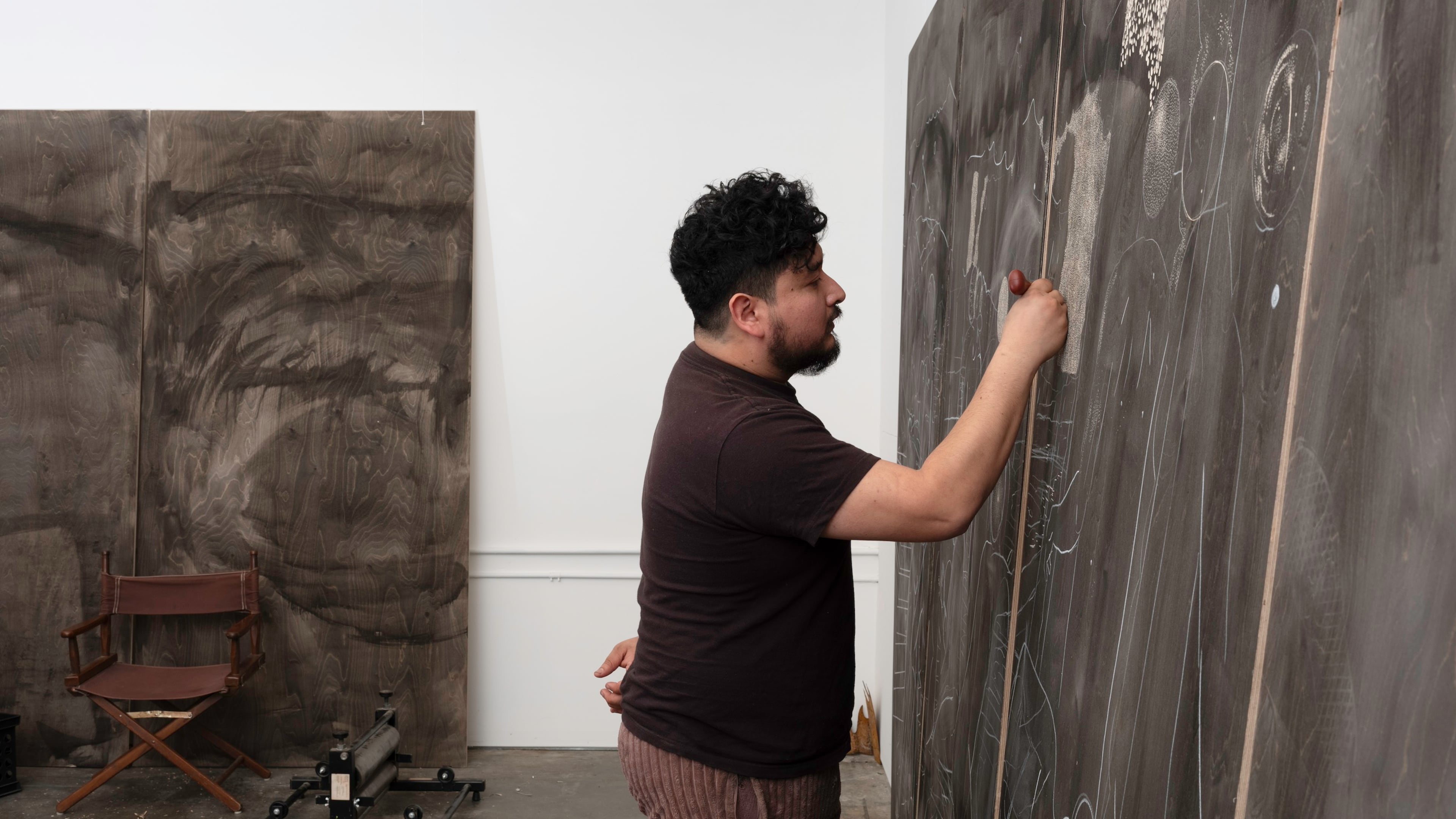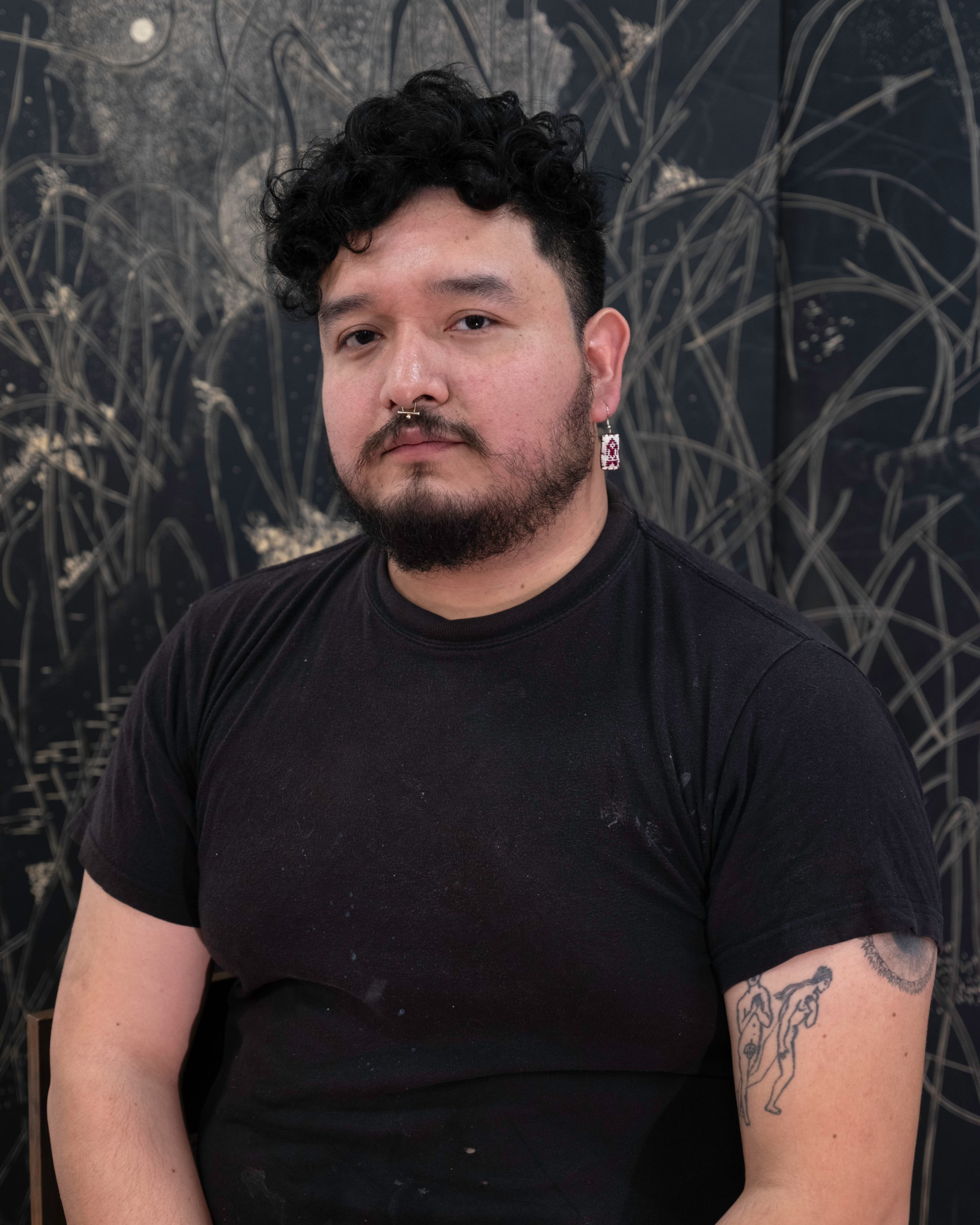Sergio Suárez’s epic prints ponder life’s big philosophical questions

You can admire a painting for the artist’s technique, for the work’s beauty. For its scale or novelty. But standing in front of one of 30-year-old Atlanta artist Sergio Suárez’s artworks inspires something else.
You could call it awe.
There is an indescribable, timeless gravitas to much of Suárez’s work that can feel like a glimpse into the infinite cosmos or like appraising an artifact of some ancient civilization, something of indeterminate origin unearthed and presented at an archaeological museum.
“You see different worlds in the pieces,” said collector and interim Atlanta Contemporary executive director Everett Long.
When he was contemplating buying one of Suárez’s works, Long and his partner spoke with the artist at Johnson Lowe Gallery. They were captivated by his charisma and aptitude in describing the making and meaning of his work, something not every artist relishes. “Sergio really digs deep and is excited to connect all the dots,” said Long.
“He talked us through each piece, and we spent another hour just kind of learning about his process and his world building,” said Long. “We were transfixed. You know, he’s really wonderful to listen to.”
Long ultimately purchased the 2022 mixed media work, “Invocar La Noche.” It hangs in Long’s dining room where it offers ample opportunity for rumination.
“Maybe an apocalypse is happening,” wonders Long of “Invocar La Noche,” rendered in Suárez’s usual color palette of charcoal, black and glowing shards of white depicting a faceless male figure flanked by flames, his head and body part of the night sky.
“Is it the beginning of the end?” asks Long.

Creating a personal mythos
Born in Mexico City, Suárez moved to Atlanta to be with his mother at age 17. He attended Stockbridge High School, an experience he describes as “culture shock.” He had studied aeronautics at a technical school back in Mexico, but he went to Georgia State because he didn’t know what he wanted to do.
He stumbled upon a new interest after taking an elective art class, but it was a subsequent printmaking class that ignited his passion. The technical aspect of printmaking appealed to his STEM-wired brain.
“[The way] printmaking, like, systematizes the production of an image was super interesting to me,” he said. “And then we were doing things with acid and etching plates, and then lithography and silk screen. So, there was also, this friction of elements.”
“Friction” is a term Suárez uses often ― to describe the forces of history, of time’s passage and how the past and present are always in a kind of grinding interaction to create something new. It’s understandable that an artist who has moved between two worlds ― Mexico and America ― would find merit in navel gazing on the many frictions in his own life.
Staring into Suárez’s works is a contemplation — without sounding too grandiose — of mortality, history, time and big philosophical questions he likes to ponder. His spiritual, metaphysical work suggests the history painting and academic art produced from the 17th through the 19th centuries that often featured religious and mythological themes, but he replaces scenes of Christ or the birth of Venus with a personal mythos and cosmology forged from his own philosophical studies.
“I’m trying to articulate things that might be ineffable, but with this kind of vocabulary that I’m familiar with, which is the body, you know, which is also printmaking,” explained Suárez of some of the fixations that crop up in his prints and paintings.
“I’m really interested in history and the past and how we preserve information,” he said. His use of printmaking references that ancient art form as a communicative form much like the clay vessels he has recently begun to create to accompany his paintings and prints.
His enormous multimedia works depict worlds where figures occupy a not entirely familiar landscape, a strange land draped in darkness where the sun and moon hang like bookends in the sky and nocturnal figures are engaged in opaque, mysterious rituals. Faceless figures battle unseen forces as the landscape erupts in flames.

Solo shows and collector interest
Donovan Johnson, director of Johnson Lowe Gallery, signed Suárez in 2024. He describes the artist as “intellectually rigorous” in his combination of novel ideas and innovative form. Collectors are taking notice, and Suárez is beginning to command top billing after years of group shows. There was a palatable buzz around his solo show, “Traces of an Unseen Fire,” at the Museum of Contemporary Art of Georgia this summer. He has a solo exhibition, “Rituals of Persistence,” at Patel Brown in Toronto up through Nov. 1 and another show at Johnson Lowe scheduled for fall 2026.
Currently, Suárez is on the road with fellow painter Aineki Traverso who exhibited at the Armory Show in New York City. They return to Atlanta for dueling Atlanta Art Fair and Atlanta Art Week events.
In addition, Suárez will join dozens of other artists for the one-night-only event SITE 25 at the Goat Farm Sept. 27. Now in its second year and part of the Atlanta Art Fair, the event features artwork, performances, open studios and installations by more than 60 artists on the Goat Farm’s sprawling 12-acre campus.
For SITE 25, Suárez is creating an interactive installation called “Eye of the Beholder” that reimagines the pre-Columbian game ōllamaliztli, in which players use their hips, legs and elbows to hurl a ball through a stone ring.
“The original game was seen as a struggle between day and night, a symbolic maintenance of the cosmic order of the universe and the ritual regeneration of life,” said Suárez, who describes his installation as “an invitation to play.”
It’s a hurly-burly schedule, but Suárez seems to thrive on contact with curators and artists in Atlanta and beyond. He attributes some of his success to the connections he’s made at residencies at the Hambidge Center, Mass MoCA, Penland School of Craft and Skowhegan School of Painting & Sculpture where he’s met other creatives like filmmaker Olivia Jampol, NYC artist Trevor King and Mari Carmen Barrios Giordano whose writing about his work accompanies the Toronto exhibition. For Suárez, the goal is simple: “I try to focus on the work. And I try to build a lot of relationships.”
It’s a hustle whose origins he sees in his “very Catholic” grandmother who helped raise him in Mexico City and was known for her social savvy.
“She was very much about, you know, creating community and connections.”

On the precipice
Artist and Georgia State professor Craig Drennen, who taught Suárez as an undergrad, sees Suárez’s success as twofold. On one hand there is his unique approach to printmaking. Suárez has taken printmaking and blown it up to the size of painting, giving it new life and an epic dimension, said Drennen. On the other is his strong work ethic. For a time the two shared studio space and Drennen was blown away by Suárez’s focus and productivity.
“Part of it is just desperation, like, if you don’t have anybody there to pick you up,” said Drennen, “then you just have to work hard all the time. Sergio was one of a group who I definitely would call the hardest working, always in the studio, always thinking about the next piece, the next show.”
Suárez calls print making “the bedrock of my practice.” He remains enthralled by the way a wood carving can serve as one image that in turn creates a multiplicity of related but different images in the printmaking process.
For Suárez, time is layered like the strata of dirt and rock in the Earth’s composition. Art making is his way of arresting time, turning it into something material.
Drennen sees Suárez’s work as part of a larger zeitgeist happening in artist studios across the country, a leaning into organic materials like clay and wood, “I think that maybe in this moment, it’s a turn away from pixels and digitals and NFTs to get back to like a physical, heavy thing.”
Suárez may be on the precipice of something even bigger, said Drennen. He sees Suárez’s potential trajectory as not unlike that of former Atlanta artists Nikita Gale and Shara Hughes who have both done exceedingly well since leaving the city.
“He might not be in Atlanta forever,” predicted Drennen.
ART EVENT PREVIEW
SITE 2025. 5-11 p.m. Sept. 27. $15-25. The Goat Farm, 1200 Foster St. NW, Atlanta, thegoatfarm.info


